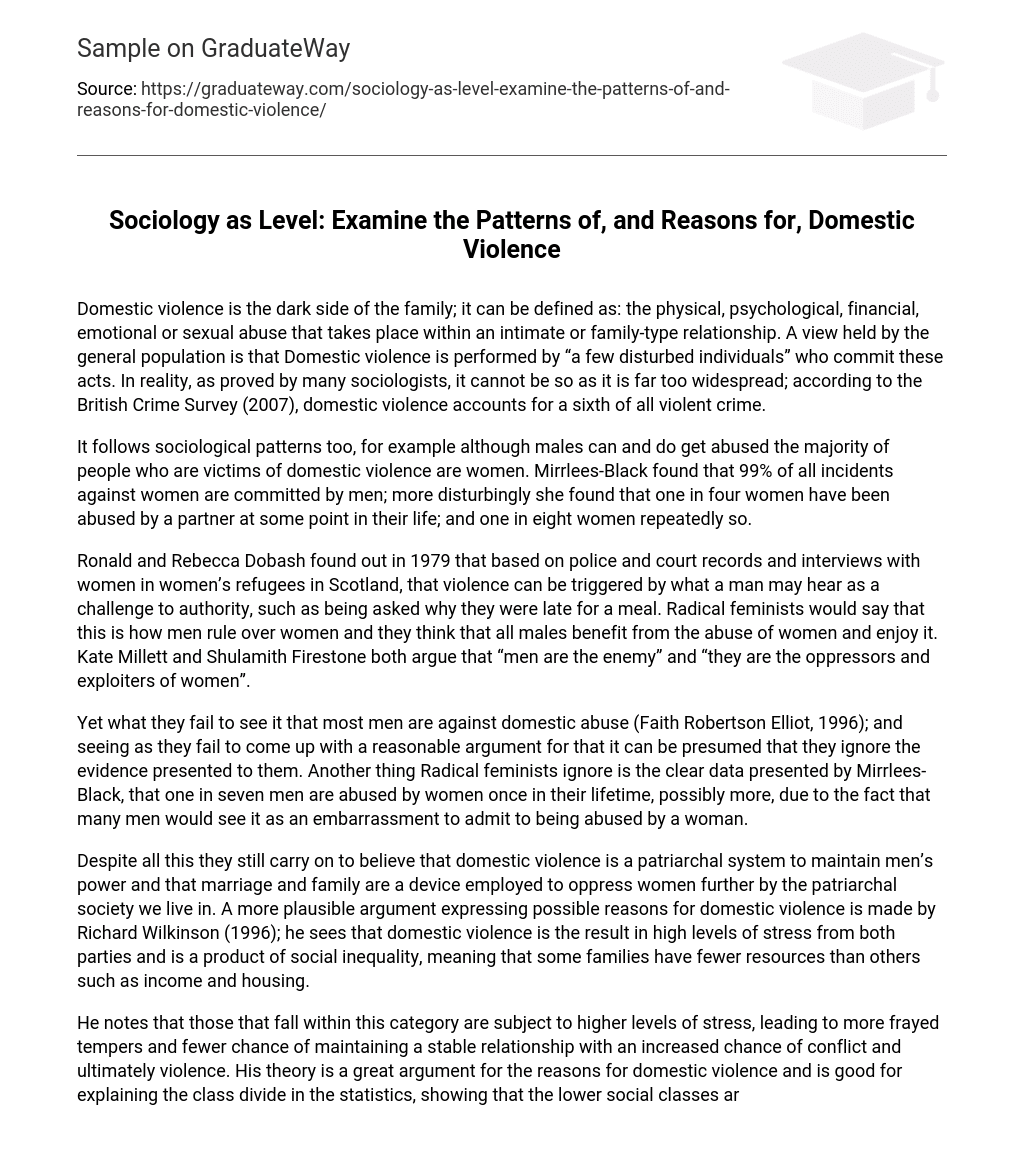Domestic violence is the dark side of the family; it can be defined as: the physical, psychological, financial, emotional or sexual abuse that takes place within an intimate or family-type relationship. A view held by the general population is that Domestic violence is performed by “a few disturbed individuals” who commit these acts. In reality, as proved by many sociologists, it cannot be so as it is far too widespread; according to the British Crime Survey (2007), domestic violence accounts for a sixth of all violent crime.
It follows sociological patterns too, for example although males can and do get abused the majority of people who are victims of domestic violence are women. Mirrlees-Black found that 99% of all incidents against women are committed by men; more disturbingly she found that one in four women have been abused by a partner at some point in their life; and one in eight women repeatedly so.
Ronald and Rebecca Dobash found out in 1979 that based on police and court records and interviews with women in women’s refugees in Scotland, that violence can be triggered by what a man may hear as a challenge to authority, such as being asked why they were late for a meal. Radical feminists would say that this is how men rule over women and they think that all males benefit from the abuse of women and enjoy it. Kate Millett and Shulamith Firestone both argue that “men are the enemy” and “they are the oppressors and exploiters of women”.
Yet what they fail to see it that most men are against domestic abuse (Faith Robertson Elliot, 1996); and seeing as they fail to come up with a reasonable argument for that it can be presumed that they ignore the evidence presented to them. Another thing Radical feminists ignore is the clear data presented by Mirrlees-Black, that one in seven men are abused by women once in their lifetime, possibly more, due to the fact that many men would see it as an embarrassment to admit to being abused by a woman.
Despite all this they still carry on to believe that domestic violence is a patriarchal system to maintain men’s power and that marriage and family are a device employed to oppress women further by the patriarchal society we live in. A more plausible argument expressing possible reasons for domestic violence is made by Richard Wilkinson (1996); he sees that domestic violence is the result in high levels of stress from both parties and is a product of social inequality, meaning that some families have fewer resources than others such as income and housing.
He notes that those that fall within this category are subject to higher levels of stress, leading to more frayed tempers and fewer chance of maintaining a stable relationship with an increased chance of conflict and ultimately violence. His theory is a great argument for the reasons for domestic violence and is good for explaining the class divide in the statistics, showing that the lower social classes are more likely to abuse their partner than those in the upper classes.
However, the only thing Wilkinson doesn’t take into account is why women are the main targets of abuse, meaning that this theory isn’t entirely bullet-proof and still has issues that need to be worked out. Although there are many theories on the reasons for domestic violence, some better than others, no one can say just yet whether we can pin-point anything which explains the entirety of the issue. However, we can gather data and formulate patterns based on the given evidence.
Although Wilkinson’s argument isn’t 100% correct, many would believe that it is a better approach to producing a viable answer, as it is more open minded. This is something that, many believe, the radical feminist view is not, as it only shows the female side of the situation; some would even go as far as to say that they need a new angle on the situation rather than the blind hatred they show towards males.





